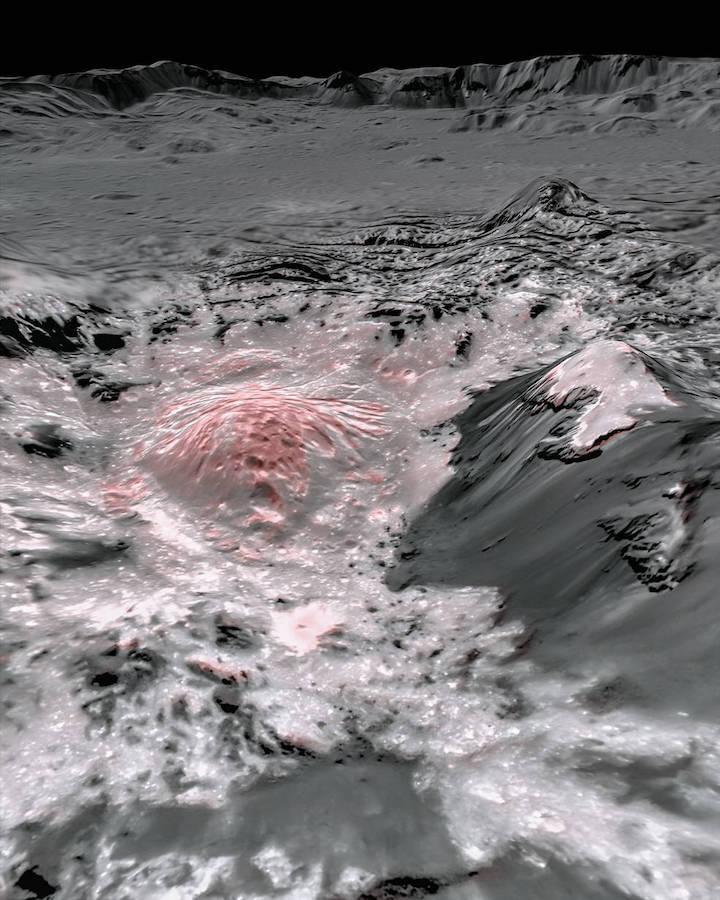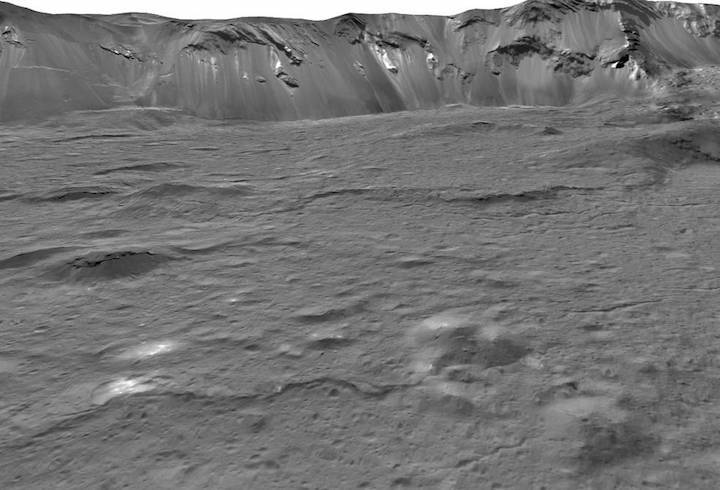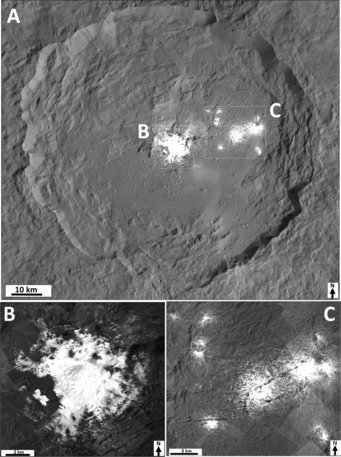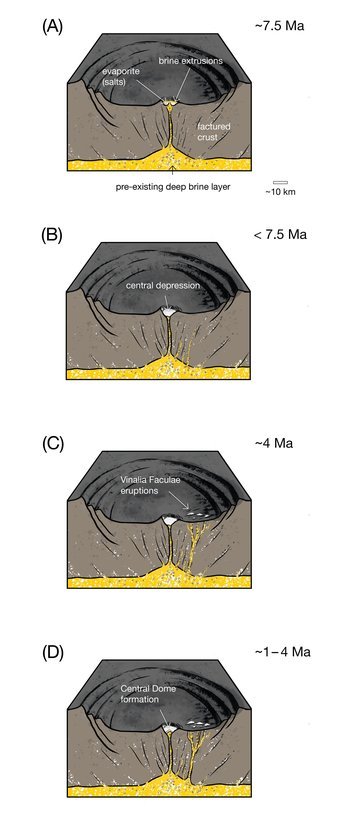11.08.2020

NASA's Dawn spacecraft gave scientists extraordinary close-up views of the dwarf planet Ceres, which lies in the main asteroid belt between Mars and Jupiter. By the time the mission ended in October 2018, the orbiter had dipped to less than 22 miles (35 kilometers) above the surface, revealing crisp details of the mysterious bright regions Ceres had become known for.
Scientists had figured out that the bright areas were deposits made mostly of sodium carbonate – a compound of sodium, carbon, and oxygen. They likely came from liquid that percolated up to the surface and evaporated, leaving behind a highly reflective salt crust. But what they hadn't yet determined was where that liquid came from.
By analyzing data collected near the end of the mission, Dawn scientists have concluded that the liquid came from a deep reservoir of brine, or salt-enriched water. By studying Ceres' gravity, scientists learned more about the dwarf planet's internal structure and were able to determine that the brine reservoir is about 25 miles (40 kilometers) deep and hundreds of miles wide.
Ceres doesn't benefit from internal heating generated by gravitational interactions with a large planet, as is the case for some of the icy moons of the outer solar system. But the new research, which focuses on Ceres' 57-mile-wide (92-kilometer-wide) Occator Crater – home to the most extensive bright areas – confirms that Ceres is a water-rich world like these other icy bodies.
The findings, which also reveal the extent of geologic activity in Occator Crater, appear in a special collection of papers published by Nature Astronomy, Nature Geoscience, and Nature Communications on Aug. 10.
"Dawn accomplished far more than we hoped when it embarked on its extraordinary extraterrestrial expedition," said Mission Director Marc Rayman of NASA's Jet Propulsion Laboratory in Southern California. "These exciting new discoveries from the end of its long and productive mission are a wonderful tribute to this remarkable interplanetary explorer."

Solving the Bright Mystery
Long before Dawn arrived at Ceres in 2015, scientists had noticed diffuse bright regions with telescopes, but their nature was unknown. From its close orbit, Dawn captured images of two distinct, highly reflective areas within Occator Crater, which were subsequently named Cerealia Facula and Vinalia Faculae. ("Faculae" means bright areas.)
Scientists knew that micrometeorites frequently pelt the surface of Ceres, roughing it up and leaving debris. Over time, that sort of action should darken these bright areas. So their brightness indicates that they likely are young. Trying to understand the source of the areas, and how the material could be so new, was a main focus of Dawn's final extended mission, from 2017 to 2018.
The research not only confirmed that the bright regions are young – some less than 2 million years old; it also found that the geologic activity driving these deposits could be ongoing. This conclusion depended on scientists making a key discovery: salt compounds (sodium chloride chemically bound with water and ammonium chloride) concentrated in Cerealia Facula.
On Ceres' surface, salts bearing water quickly dehydrate, within hundreds of years. But Dawn's measurements show they still have water, so the fluids must have reached the surface very recently. This is evidence both for the presence of liquid below the region of Occator Crater and ongoing transfer of material from the deep interior to the surface.
The scientists found two main pathways that allow liquids to reach the surface. "For the large deposit at Cerealia Facula, the bulk of the salts were supplied from a slushy area just beneath the surface that was melted by the heat of the impact that formed the crater about 20 million years ago," said Dawn Principal Investigator Carol Raymond. "The impact heat subsided after a few million years; however, the impact also created large fractures that could reach the deep, long-lived reservoir, allowing brine to continue percolating to the surface."
To learn more about Ceres, zoom in and give the dwarf planet a spin. Use the search function at bottom to explore about just about anything else in our solar system. For the full interactive experience, visit Eyes on the Solar System.
Active Geology: Recent and Unusual
In our solar system, icy geologic activity happens mainly on icy moons, where it is driven by their gravitational interactions with their planets. But that's not the case with the movement of brines to the surface of Ceres, suggesting that other large ice-rich bodies that are not moons could also be active.
Some evidence of recent liquids in Occator Crater comes from the bright deposits, but other clues come from an assortment of interesting conical hills reminiscent of Earth's pingos – small ice mountains in polar regions formed by frozen pressurized groundwater. Such features have been spotted on Mars, but the discovery of them on Ceres marks the first time they've been observed on a dwarf planet.
On a larger scale, scientists were able to map the density of Ceres' crust structure as a function of depth – a first for an ice-rich planetary body. Using gravity measurements, they found Ceres' crustal density increases significantly with depth, way beyond the simple effect of pressure. Researchers inferred that at the same time Ceres' reservoir is freezing, salt and mud are incorporating into the lower part of the crust.
Dawn is the only spacecraft ever to orbit two extraterrestrial destinations – Ceres and the giant asteroid Vesta – thanks to its efficient ion propulsion system. When Dawn used the last of a key fuel, hydrazine, for a system that controls its orientation, it was neither able to point to Earth for communications nor to point its solar arrays at the Sun to produce electrical power. Because Ceres was found to have organic materials on its surface and liquid below the surface, planetary protection rules required Dawn to be placed in a long-duration orbit that will prevent it from impacting the dwarf planet for decades.
JPL, a division of Caltech in Pasadena, California, manages Dawn's mission for NASA's Science Mission Directorate in Washington. Dawn is a project of the directorate's Discovery Program, managed by NASA's Marshall Space Flight Center in Huntsville, Alabama. JPL is responsible for overall Dawn mission science. Northrop Grumman in Dulles, Virginia, designed and built the spacecraft. The German Aerospace Center, Max Planck Institute for Solar System Research, Italian Space Agency and Italian National Astrophysical Institute are international partners on the mission team.
Quelle: NASA
----
Update: 16.08.2020
.
Cryovolcanism on Ceres
Data from the last months of NASA’s Dawn mission paint a unique picture of the dwarf planet
Until a million years ago, dwarf planet Ceres, the largest body in the asteroid belt, was the scene of cryovolcanic eruptions: below the Occator Crater, subsurface brine pushed upward; the water evaporated, leaving behind bright, salty deposits. This process is probably still ongoing. A team of researchers led by the Max Planck Institute for Solar System Research (MPS) in Germany comes to these conclusions after evaluating high-resolution camera images of Ceres from the final phase of NASA's Dawn mission. The scientific journals Nature Astronomy, Nature Geoscience, and Nature Communications today dedicate a total of seven articles to this and other results from the Dawn mission. The publications paint a picture of a unique world, in whose interior remains of a global ocean have survived to this day and whose remarkable cryovolcanism is probably still active.
Cryovolcanism has long been considered a phenomenon of the outer solar system, occurring exclusively on some icy moons of Jupiter, Saturn, Uranus, and Neptune. Churned by the enormous gravitational forces of their mother planets, these moons offer so much warmth in their interior despite the considerable distance from the Sun that the water within does not freeze completely and is sometimes ejected into space in spectacular plumes. In contrast, the asteroid belt offers a completely different setting. The many millions of larger and smaller chunks that orbit the Sun between the orbits of Mars and Jupiter are generally regarded as simply structured, waterless, and inactive bodies.

These mosaics of Occator Crater are composed of several images taken by Dawn’s Framing Camera from a distance of 35 kilometers. Within the crater, which has a diameter of 92 kilometers (A), there are two areas of bright deposits. The deposits in the center of the crater, called Cerealia Facula (B), measure only a few kilometers in diameter. In its center a dome bulges upwards. The deposits in the northeast of the crater are called Vinalia Faculae
Today’s publications prove that this view cannot be upheld. Ceres, the largest inhabitant of the asteroid belt with a diameter of 950 kilometers, turns out to be an active body displaying a unique form of cryovolcanism. The researchers' findings are primarily based on observational data from the final phase of NASA's Dawn mission, which examined Ceres from 2015 to 2018. In its final five months on a strongly elliptical orbit, the space probe ventured within 35 kilometers of the surface - closer than ever before. The probe's scientific camera system, which was developed and built under the leadership of MPS, took unique pictures during this time.
The authors of today’s papers including researchers from the University of Münster (Germany) and the National Institute of Science Education and Research (NISER, India) paid special attention to Occator Crater, a prominent impact crater in the northern hemisphere of Ceres. With a diameter of about 92 kilometers, its dimensions exceed even those of most terrestrial craters. Even more striking is its bright white coloration, which prompted speculation about possible water deposits already during the approach to Ceres. "On closer inspection, Occator Crater has a very complex structure with elevations, a large central depression, deposits, cracks, and furrows. In all its details, this became clear only during the final phase of the mission," explains Dr. Andreas Nathues from MPS, Principal Investigator of Dawn's camera team. "From the crater's current morphology, we can reconstruct its evolution - and thus take a look at Ceres' eventful past," he adds.
The high-resolution images make it possible to determine the age of the individual crater areas. To this end, researchers analyze the number and nature of impact craterings that cover every body in the solar system. The younger the surface is, the fewer small craters it exhibits.
As it turned out, Occator Crater was formed about 22 million years ago by a large impact. As in many other impact craters on Earth and on other planets, a central peak was formed, which collapsed again after some time. About 7.5 million years ago, brine rose to the surface within the remnants of the central peak. The water evaporated and certain salts, so-called carbonates, remained. They are responsible for the prominent bright deposits we see today, called Cerealia Facula, in the center of Occator Crater. Due to the loss of material in the interior, the inner part of the crater subsided. A round depression with a diameter of about 15 kilometers formed.
The center of Occator Crater
In the following millions of years, activity concentrated mainly on the eastern part of the crater floor. Through cracks and furrows, brine also rose to the surface there and produced further bright deposits, the Vinalia Faculae. About 2 million years ago the center of the crater woke up again: brine rose to the surface and within the central depression a dome of bright material was formed. "This process continued up to a million years ago and maybe even until today," Dr. Nico Schmedemann from the University of Münster summarizes.
"What is particularly remarkable is how long Occator Crater was active and possibly still is", says Nathues. He believes this refutes theories according to which the escaped fluid is exclusively due to meltwater from the original impact. The heat generated by such an impact could not have been sustained inside the body for so many millions of years.

Instead, the results suggest that deep below Occator Crater there are remnants of a global, salty ocean. Similar to road salt in winter, the dissolved salt ensures that the brine remains liquid despite the low temperatures inside the dwarf planet. This interpretation is supported by another article published today, in which MPS was also involved. The scientists from NASA's Jet Propulsion Laboratory (JPL) evaluate Dawn's gravity measurements. According to their analysis, a reservoir of liquid brine lies about 40 kilometers below Occator Crater.
Possibly, that water is still escaping from Ceres. In 2014, a publication of observations with the Herschel Space Telescope provided indications of an extremely thin, water-containing and possibly only sporadically occurring exosphere. During the following Dawn mission, Nathues and his team found signs of a kind of thin haze apparently existing intermittently over the floor of Occator Crater. These pieces of the puzzle are now joined by the publication of the Dawn spectrometer team led by the Istituto di Astrofisica Spaziale e Fisica Cosmica in Italy. The researchers were able to detect salt compounds containing water in the bright, deposited material. However, the lightly bound water evaporates from Ceres’ surface quickly; the deposits can therefore not be old. “Their work is complimentary to ours, particularly our finding of a unique spectrally red nature in Cerealia Facula from our Framing Camera color data”, says Dr. Guneshwar Thangjam from NISER.
"We assume that Ceres is still occasionally cryovolcanically active," concludes Nathues. While there is some evidence that the eruptions in the early developmental phases of Occator volcanism were in part quite explosive, this process should have calmed down considerably by now. The researchers suspect that water now escapes primarily through evaporation and sublimation. "According to current knowledge, such cryovolcanism is unique in the solar system," says Schmedemann. In addition, Thangjam opined, “The evidence for very recent geological activity on Ceres contradicts the general belief that small solar system bodies are not geologically active. This has paved a new direction in planetary science exploration toward understanding conditions of the very early solar system as well as having implications for habitability”.
Quelle: Max-Planck-Gesellschaft

